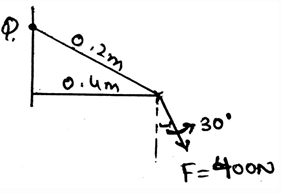Test: Frictional Forces On Journal Bearings - Civil Engineering (CE) MCQ
15 Questions MCQ Test Engineering Mechanics - Test: Frictional Forces On Journal Bearings
The journal bearings are generally used in __________
A phenomena is there in these collar bearings and pivots, which is very helpful in the supporting of the machines, and that is _____________
| 1 Crore+ students have signed up on EduRev. Have you? Download the App |
Determine the moment about the point Q by the force shown as 400N.

At what conditions does the Coulomb friction occurs between the surfaces in contact of journal bearing?
We first make equilibrium equations of the sections involving the journal bearings by considering all the three dimensional forces acting on the section chosen and then the free body diagram is made and solved.
To know the rotations involved in the journal bearings we use right handed coordinate system, in that system which of the following is followed (consider the mentioned axis to be positive)?
The moment is the cross product of which two vectors in the calculations of the journal bearings?
Determine the moment about the point P.
The basic type of motion of a body is not the translation motion only.
Sometime the principle of transmissibility is somehow applied to journal bearings. It states that:
Coplanar forces are not easily simplified in the simplification of the force and couple system in the calculations of forces in the journal bearings.
There are some of the applications of the two force and three force members in the journal bearings. The difference between the two and the three force members is:
Which of the following is true for the determination of the rotational effect of the bearings?
The doors are having hinges to support them. This hinge is too a type of bearing or is a Device which is using effect like bearing to support. So, if you are opening the door, then the force you apply is greater if you open it from the part closer to the hinges.
Which of the following is true for the bearing’s body?
|
24 videos|59 docs|53 tests
|
|
24 videos|59 docs|53 tests
|

















